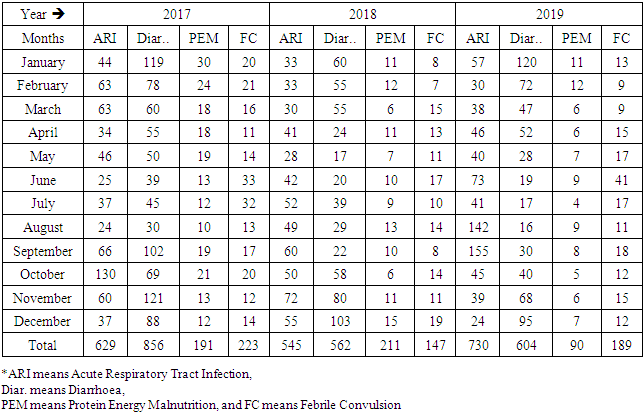-
Paper Information
- Paper Submission
-
Journal Information
- About This Journal
- Editorial Board
- Current Issue
- Archive
- Author Guidelines
- Contact Us
International Journal of Prevention and Treatment
p-ISSN: 2167-728X e-ISSN: 2167-7298
2020; 9(1): 9-15
doi:10.5923/j.ijpt.20200901.02

A Study on Admitted Indoor Patients Management in Paediatric Ward of Medical College Hospital
Md. Shahariar Khan1, Md. Rahimullah Miah2, Tania Hussain1, Syed Moosa M. A. Quaium1, Azizur Rahman1
1Department of Paediatrics, Northeast Medical College & Hospital, Sylhet, Bangladesh
2Department of Information Technology in Health, Northeast Medical College & Hospital Pvt. Limited, Sylhet, Bangladesh
Correspondence to: Md. Shahariar Khan, Department of Paediatrics, Northeast Medical College & Hospital, Sylhet, Bangladesh.
| Email: |  |
Copyright © 2020 The Author(s). Published by Scientific & Academic Publishing.
This work is licensed under the Creative Commons Attribution International License (CC BY).
http://creativecommons.org/licenses/by/4.0/

An explorative study assesses on hospital admitted indoor patients at the Paediatric Department of Northeast Medical College and Hospital of Bangladesh with neonate and general patients of both sexes with common diseases. This prospective observational study was shown in the department of Paediatrics in Private Medical College Hospital over three years. Hundred admitted indoor patients of common diseases were included for interviews. Data were collected in respect to the patient’s profile, diagnosis and death records. Indoor Hospital Admitted Patients in total was 10737 from 2017 to 2019, but admitted patients were more in 2019 than other years. ARI was more prevalent in September, October and November but diarrhea in November, December and January and febrile convulsion in June round the year. The study found the ARI infected via touching, sneezing, coughing and also even breathing in connection with corona effect. The study illustrated the common diseased patients were more in 2017 but it was reduced in 2019. The death records were gradually reduced in the consecutive year. A scientific model was developed to recover the common diseases with hospital admitted indoor patients’ management. The high authority can take earlier preventive measures to provide high quality, training, safe health care with appropriate policies, equipment, facilities and personnel then the mortality and morbidity can be reduced significantly linking with Sustainable Development Goals 2030.
Keywords: Admitted indoor patients, Paediatric ward, Common diseases, Death records
Cite this paper: Md. Shahariar Khan, Md. Rahimullah Miah, Tania Hussain, Syed Moosa M. A. Quaium, Azizur Rahman, A Study on Admitted Indoor Patients Management in Paediatric Ward of Medical College Hospital, International Journal of Prevention and Treatment, Vol. 9 No. 1, 2020, pp. 9-15. doi: 10.5923/j.ijpt.20200901.02.
Article Outline
1. Introduction
- Approximately 6.3 billion children under 5 years die in each year in the world (Mollah and Nahar, 2018). Diarrhea and pneumonia and were the main causes of child mortality, accounting for 8.9 and %, 15.5 respectively, of deaths among children under 5 years of age in 2015 (Liu et al., 2016). The root causes of deaths are due to acute respiratory infections (ARI), diarrhea, malnutrition and neonatal diseases ((Bulla and Hitze, 1978). Most of the deaths occurred in under-developed and developing countries like Bangladesh. The common causes of under-five mortality are neonatal diseases, namely perinatal asphyxia, preterm low birth weight, sepsis, congenital abnormalities, malformations; besides diarrhea, malnutrition, pneumonia and drowning etc. in Bangladesh. Out of them, neo-natal deaths are about two-thirds of all infant deaths in Bangladesh (Ullah et al., 2019); Mollah and Nahar, 2018). Pneumonia is an acute inflammation in lung parenchyma (Khan & Rahman, 2011), which is the leading infectious causes of death among children of under-five years’ old (Khan & Rahman, 2011; ICDDRB, 2015). About the 16% of deaths of children under this age occurred in pneumonia. Out of deaths, most of them were under two years old (ICDDRB, 2015). Annual child deaths from pneumonia decreased by 47% from 2000 to 2015, from 1.7 million to 922,000 million globally (ICDDRB, 2015). Tremendous improvement in child survival has been made over the past 20 years (UN IGME, 2019). In Bangladesh, between 1990 and 2011, under -5 mortality decreased from 151 to 53 per 1000 live births (LBs). The infant mortality rate fell less rapidly from 87/1000 to 43/1000 lbs over the last 18 years. Mortality declines are associated with improved coverage of effective interventions to prevent or treat the most important causes of child mortality and with improvements in socioeconomic conditions. Pneumonia is responsible for around 28% of the deaths of children under five years of age, which are around about 50,000 each year. An estimated 80,000 children under five years are admitted to hospital with virus-associated acute respiratory illness each year; the total number of infections is likely to be much higher (ICDDRB. (2015). It can be caused by a wide range of bacteria, viruses and also seldom fungal and parasitic infections. In Bangladesh, co-morbidity of pneumonia and malnutrition is prevalent and frequently associated with death. This disease accounts for approximately 15% of 1, 19,000 deaths among Bangladeshi children aged less than five years (Chowdhury et al., 2020). About 36% of children aged less than five years are malnourished and 12% of them have severe acute malnutrition in Bangladesh. The Two-thirds of the malnourished children admitted to hospital are diagnosed with pneumonia, which is crucial to target malnourished children with pneumonia with the highest risk of death to have a significant impact on global child mortality through proper pneumonia case management. The most common causes of diarrhea include mostly viruses, also bacteria (Chowdhury et al., 2020). Febrile convulsion commonly occurs in between the age of 6 months and 60 months with a temperature of 38°C or higher, those are not due to central nervous system (CNS) infection or any metabolic imbalance and occur in the absence of a history of previous a febrile seizure (Mollah and Nahar, 2018). Careful monitoring of patients and on call service should also be in place (Maswood, 2019). These diseases may present with so many complications (Sethi, 2019). The study focuses hospital admitted indoor patients in the Paediatric ward on the provision of clinical care due to the fact that a vast majority of children in Bangladesh face barriers to access quality hospital-based care causing in thousands of deaths each year from preventable causes. The study assessed the collected quantity data for rate of occurrence, status and death of indoor patients (Lozano et al., 2012). The aim of this study is to evaluate the common childhood diseases who are admitted at indoor paediatric department in private medical college hospital and their management.
2. Methodology
- This was a prospective observational study conducted in the department of Paediatrics at Northeast Medical College Hospital (NEMCH), Sylhet, Bangladesh from January 2017 to December 2019. Primary and Secondary data were collected as following manners.Data CollectionPrimary data were collected from the NEMCH in Bangladesh pertaining to common diseases in children from the existing ward. Patients’ data were also collected through questionnaire survey among 100 patients from this department. Informal discussion is integrated with the patient’s guardian like father, mother, grandmother, aunt, uncle, etc. at the Northeast Medical College Hospital. Meanwhile, secondary data were collected from diverse sources like ICDDRB, NEMCH central library, journals, daily news, books, different web pages and relevant update sources. Selection CriteriaCommon diseases are ARI, Diarrhoea, Malnutrition, Febrile convulsion and other diseases, and also death records within the mentioned period.Data CompilationAll general information regarding common diseases and death reports, patients’ data were compiled according to the research objective. Data Analysis and InterpretationCompiled data were integrated for analysis and interpretation as findings using standard data analysis software like SPSS version 26, MS Excel 2016 and R programming version 3.5.
3. Results
- From the socio-profile of patients’ data illustrated on health awareness in common diseases, particular idea of ARI, diarrhea, malnutrition, sanitation, drinking water and service satisfaction and the patient’s status, which as shown in Table 1. The study enhances on diarrhea and malnutrition.
|
3.1. Total Patients Status
- From field observation, the grand total of patients in Paediatric department is 10737, out of them 3594 in 2017, 3329 in 2018 and 3814 in 2019. But in the year 2019, the patients were maximized, which as shown in Figure 1. The curve also indicated with linear equation for total patients to compare with different years.
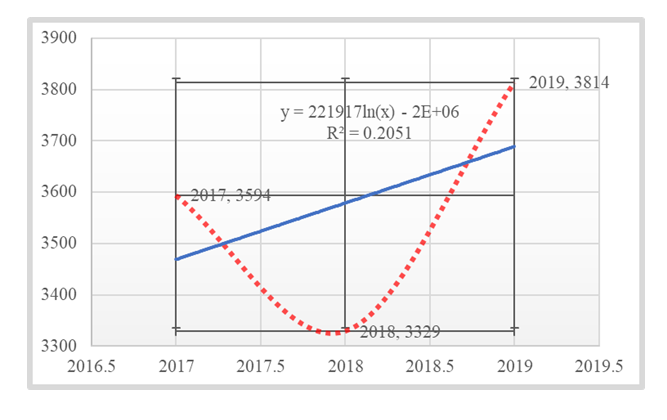 | Figure 1. Total Patients Status at Paediatric Department of NEMCH |
3.2. Neonate and General Patients Status
- From survey at NEMCH, there are 3622 neonatal and 7115 general patients (other than neonate) at Department of Paediatrics from January 2017 to December 2019, among them, the general patients are more than neonatal disease, which as shown in Figure 2. The figure also illustrated with polynomial graph to compare with different years in general patients.
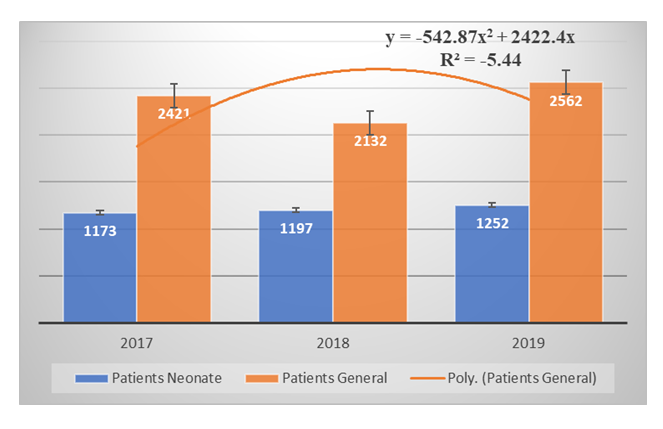 | Figure 2. Neonatal and General Patients Status at Paediatric Department of NEMCH |
3.3. Male and Female Patients
- From patient register of NEMCH, the total neonate male 1915 and female 1707, meanwhile general male 3628 and female 3487 of patients at Department of Paediatrics from 2017 to 2019. All the year the disease occurrence, male from neonate and general are more predominant than females, which as shown in Figure 3. The curve also indicated by a logarithm line for patients to compare with different sex variations.
 | Figure 3. Sex variations in different Patient Status at Department of Paediatrics of NEMCH |
3.4. Year wise different Diseases Status
- From the year wise common disease survey at NEMCH, in 2017 and 2018, the incidence of diarrhea were more in 856 and 562 respectively. On the other hand, in 2019, ARI was more in 730 in number than other diseases, which as shown in Figure 4. The figure also demonstrated with a polynomial equation to compare with different year wise diseases status.
 | Figure 4. Year wise distribution of various Patient Status at Department of Paediatrics, NEMCH |
3.5. ARI, Diarrhoea, Malnutrition and Febrile Convulsion Disease Prevalence
- From the survey at NEMCH, the total patients are 4977 including ARI, diarrhea, malnutrition and febrile convulsion from January 2017 to December 2019. These mentioned diseases are epidemic diseases except malnutrition. The study observed that ARI is maximum in the month of September, October and November, and diarrhea is maximum in November, December and January in the successive years, again febrile convulsion is more June, which as shown in the Table 2. The study opined for preventive measure before the stipulated months.
|
3.6. Yearly Death Review
- In Bangladesh, infant mortality rate (IMR) is gradually declining (Figure 5). In 2008, the IMR was 43.2 meanwhile it was 25.1 in 2018 per thousand live births (Statista, 2020).
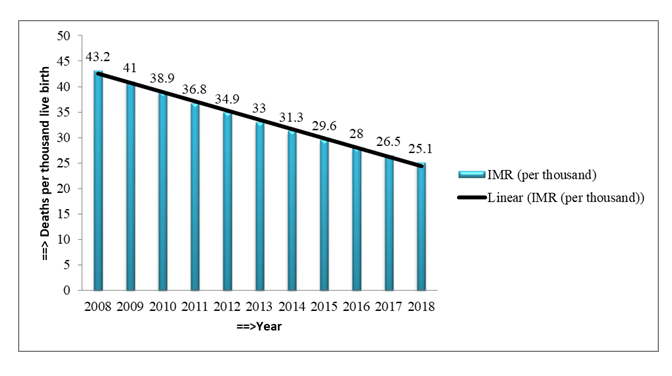 | Figure 5. Infant Mortality Rate in Bangladesh from 2008 to 2018 (Statista, 2020) |
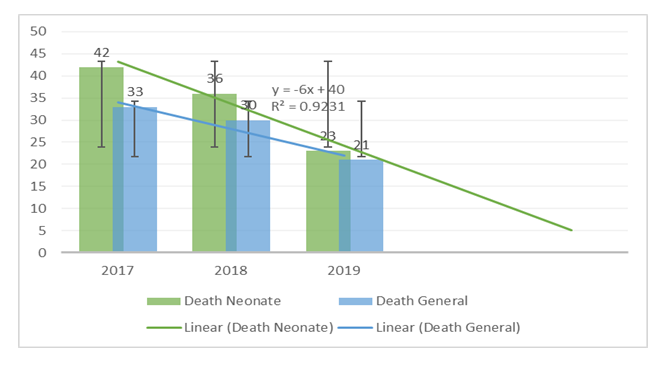 | Figure 6. Year wise death distribution at Department of Paediatrics, NEMCH |
4. Discussion
- The study illustrated on indoor patients’ status with neonate and general sex distribution at the Department of Paediatrics in Northeast Medical College Hospital from 2017 to 2019. The findings exposed to different diseases, including ARI, Diarrhea, Malnutrition, Febrile convulsion and others. Overall, the ARI is predominant in September, October and November, but Diarrhea is more in November, December and January in each year. On the other hand, febrile convulsion is more in June. In 2017 the common diseased patients are more, but in 2019, it is reduced. It is mentioned that the death record is gradually decreasing in the successive year. If the higher authority can take earlier preventive measure, then the mortality and morbidity can be reduced significantly (Dock et al., 2017). The study also observed the ARI may infect via touching, sneezing, coughing and also even breathing. The occurrence happened more in the age of 2 months to 2 years. Mainly fast breathing and cough-cold are usual common manifestations in this disease. The hospital authorities can be organized for isolation and quarantine of all patients and suspected cases and giving treatment accordingly. Out of the hospital admitted patients, the most common case is ARI and Diarrhea (Hoang et al., 2019). Most of the cases treated accordingly to take weeks to recover completely. These difficult conditions are very much significant due to great mortality and illness. In addition, sometimes it may remain asymptomatic or silent (Son et al., 2017). Life-threatening problems can happen if the patient is severely compromised immune or has gone for a long time without treatment. It is possible to death of children due to ARI and Diarrhea so doctors will propose the condition earlier (Johnson, 2018; Green et al., 2019). The research mentioned that mortality can be reduced with the effective coverage, treatment and prevention of severe causes of child mortality, according to progress in social status (MOHFW, 2015). In Bangladesh, child mortality rate reduces within successive year, for example, in 2010 the value was 49.1 but the value reduces 30.2 in 2018 (WDA, 2020).According to the linear, polynomial and log equations represent to downward direction gradually, which indicates to lack of awareness regarding ARI, Diarrhea and Malnutrition. If we give awareness about vaccination, and maintain hygiene, hand washing, safe drinking water, proper sanitation, ideal breastfeeding and weaning, healthy lifestyle, living in quiet and calm environment, we can prevent these diseases as well as decreases morbidity and mortality. The authority of hospital has arranged a dynamic model of sustainable health service delivery for various low-middle-income groups, delivering a full spectrum of in-patient, emergency, surgical, diagnostic, lab and pathology, out-patient, and other expert care under one roof and through medical professionals, trained-up nurses/paramedics and technologists. Now a day’s microbiologist revealed that the lung is not germfree, and quarantines in case of different diseases with aerobes and diverse culture (Neil and Dean, 2019). For treatment purposes, ARI should include broad spectrum coverage of antibiotic are necessary to improve the condition and manage quickly to prevent further complications. Moreover, the aiming of prevention, enhanced relevant diseases and reducing mortality and morbidity is realistic. Life-threatening problems can happen if the patient is severely compromised immune or has gone for a long time without treatment. The research mentioned that mortality can be reduced with the effective coverage, treatment and prevention of severe causes of child mortality, according to progress in social status (MOHFW, 2015). In Bangladesh, child mortality rate reduces within successive year, for example, in 2010 the value was 49.1 but the value reduces 30.2 in 2018 (WDA, 2020). According to the polynomial and exponential equations represent to downward direction gradually, which indicates to increase of awareness regarding indoor patient management. A dietitian should include for adequate feeding and maintenance of proper nutrition of the child. Administration of humidified oxygen and nebulization with bronchodilator can be given. We can reduce this by limiting the risk factors and colonization of pathogenic organisms. A comprehensive neonatal emergency service had been organized in place for improvement (Sharif, 2019). There are expanded immunization programmes, the Diarrheal disease control programme, deworming, Vitamin A supplementation programme, awareness programme regarding clean and save delivery and other nutritional programme played a role in improving child health (Moral, 2019). Scientific Control Model is effective on the priority of condition or situation in connection with indoor patient management. From Figure 7, the study has shown that following parameters enhance with indoor, such as techno-psychological supports with awareness, maintenance with nutritional support, associated with vigorous treatment and follow up counseling. Knowledge of common diseases, mind set-up, motivation about risk and doctor’s advices is followed up conditions and nutritional supports to prevent recurrence. Overall, an innovative model with indoor hospital patients is suitable for milestone-setting in case of children for sustainable health service delivery.
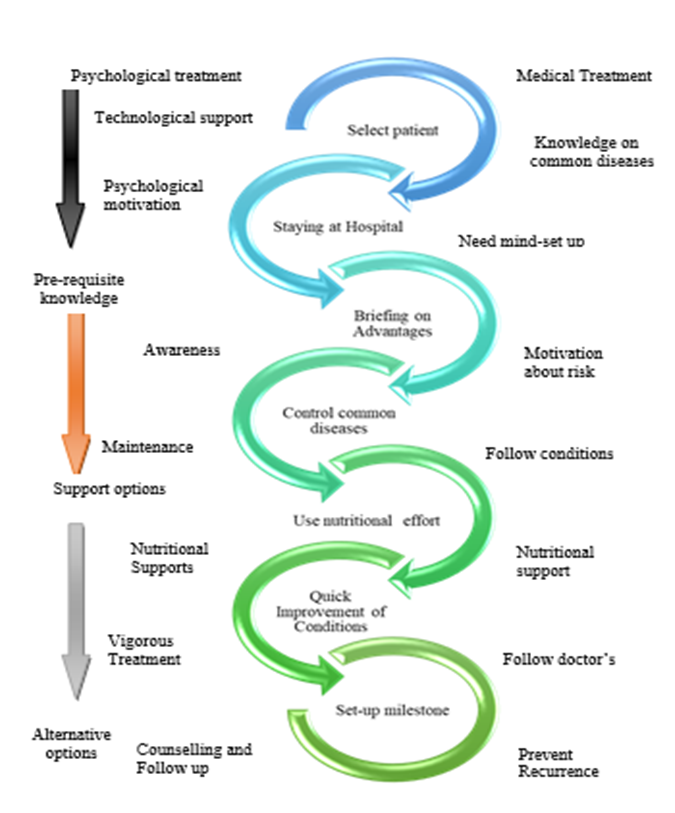 | Figure 7. A Scientific Control Model for Recovery of Common Diseases |
4.1. Challenge of the Study
- In national perspectives, there are diverse challenges in research on common diseases in Paediatric ward. However, the guardians are not felt comfortably during health education. Corona disease is also pandemic in connection with common diseases. There are limited data on common diseases research and less technological support. The Sustainable Development Goals adopted by the United Nations in 2015 were developed to promote healthy lives and well-being for all children to reduce under-five mortality to at least as low as 25 per 1,000 live births in every country (WHO, 2019). Bangladesh, as a developing country, it is difficult to fulfill the targets of SDGs due to unwanted situation.
5. Conclusions
- In concluding hospital admitted indoor patients in the Paediatric department enhances the study in connection with neonate and general patients of both sexes with common diseases. ARI is more prevalent in September, October and November but diarrhea in November, December and January and febrile convulsion in June round the year. The study also observed the ARI may infect via touching, sneezing, coughing and also even breathing in connection with corona effect. According to this study, these common diseased patients are more in 2017 but it is reduced in 2019. Moreover, the death record is gradually reduced in the consecutive year. If the higher authority can take earlier preventive measures to provide high quality, training, safe health care with appropriate policies, equipment, facilities and personnel then the mortality and morbidity can be reduced significantly linking with Sustainable Development Goals 2030. The study recommends for future research trajectory with a methodological agenda on admitted indoor patients in private medical college hospitals.
Disclosure
- Data AvailabilityThe data are being used to support the findings of this research work are available from the corresponding author upon request. Competing InterestsThe authors declare no potential conflict of interests in this research work.
ACKNOWLEDGEMENTS
- The authors acknowledged the authority of NEMCH, Sylhet, Bangladesh for kind support.
 Abstract
Abstract Reference
Reference Full-Text PDF
Full-Text PDF Full-text HTML
Full-text HTML
